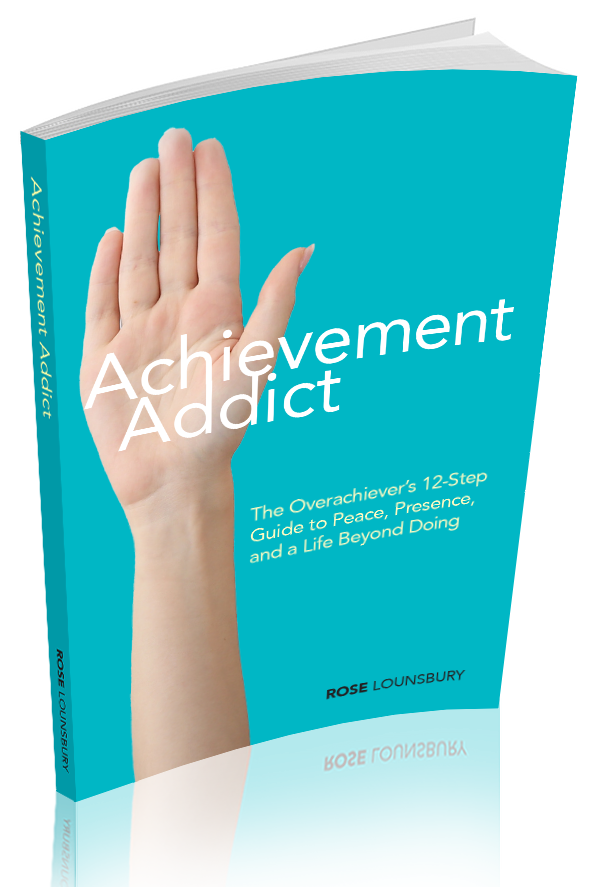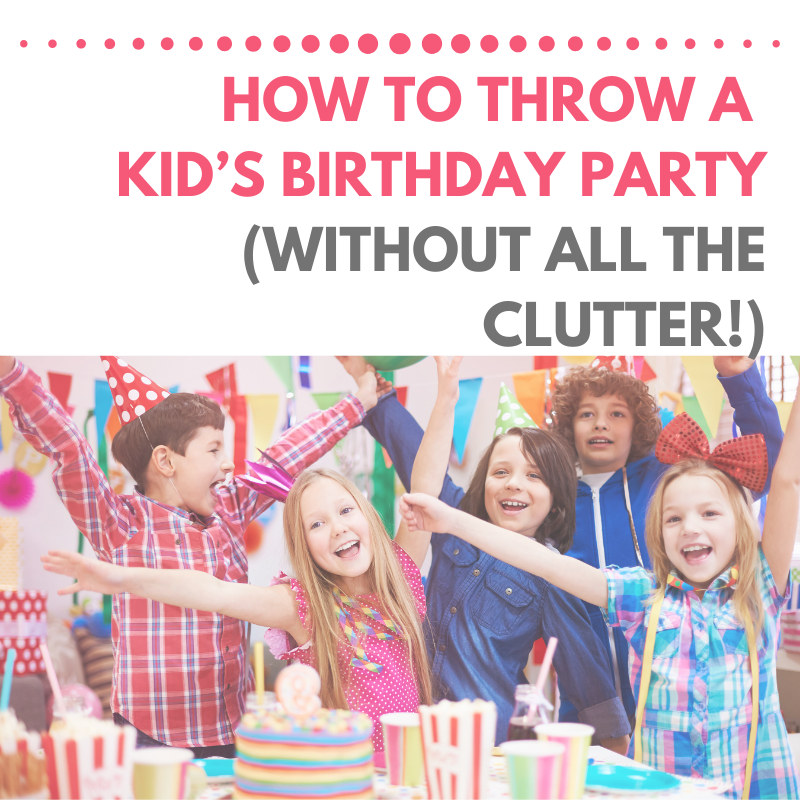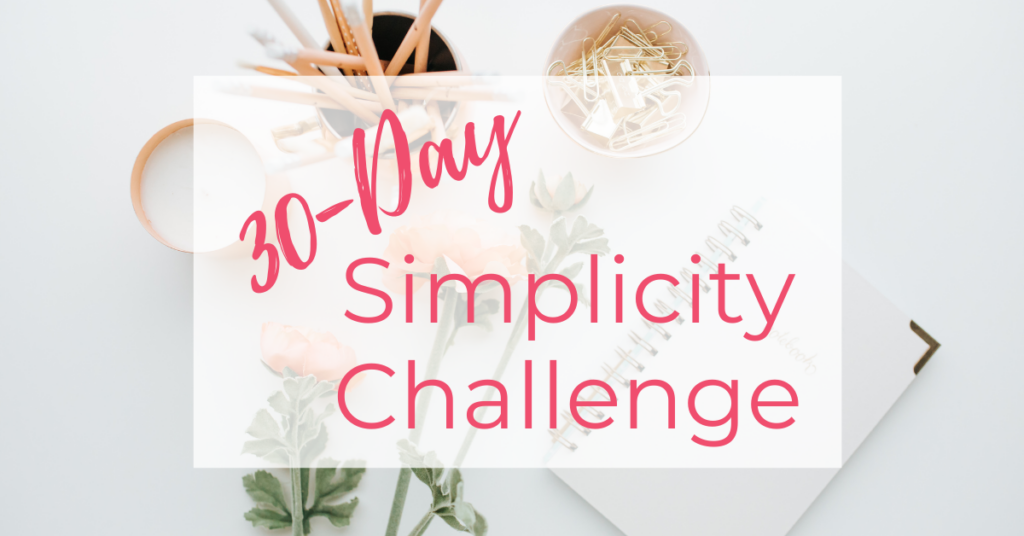My triplets will turn 13 tomorrow. (Yes, I will have three teenagers all at once… please send prayers! 😂)
Now that they’re older, they’ve moved beyond the I-want-to-invite-every-single-kid-I-know type of birthday party. But I know that many of you mamas are in the midst of the big birthday party season of life, so I thought this would be a good time to share some things I’ve learned about throwing a kid’s birthday party, clutter-free.
I used to think that you couldn’t throw a big birthday party without acquiring tons of clutter. But it is possible! With some planning and communication, your child’s party does not have to be an all-access pass for clutter.
I avoided big birthday bashes until my kids were eight for a few reasons. First, my kids’ birthday is in mid-July, often when many families (including ours) are on vacation. Also, since they were out of school, they really didn’t have friends on the mind that much. Before age 8, their parties were small gatherings of family friends, often in the backyard, or a big outing with just one or two friends.
But… as my kids got older, things changed. They went to enough big parties to want one for themselves, and they started putting on the full-court big party press. I was triple-teamed and knew it was time to figure out how to to a clutter-free big party.
So, after years of hosting bashes with lots of kids and very little clutter, I’ve learned 6 lessons. Hopefully they will help you, too!
Lesson 1: Communicate With Your Kids
If we’re throwing a pricier bash (for example, laser tag or rock climbing where you have to pay per child), we are very clear with the kids: the party is their present. We explain that big parties cost money, and we’ll happily give them the party as our present to them. The kids are fine with this, but it’s because we’re very upfront about it.
If the venue isn’t expensive–for example, a shelter at a local park–we tell the kids that the party won’t have presents, but that we will give them presents at home. (We usually do birthday presents in the morning when they wake up, similar to Christmas.) Again, they’re totally fine with this because they know ahead of time. We give our kids 2-3 presents each for birthdays, and this seems normal to them because this is the number they are used to.
Lesson 2: Communicate With Your Guests
If you don’t tell your guests what to expect, then they will follow social norms and bring typical kid presents such as toys and games. So it’s up to you to tell your guests–as clearly as possible–exactly what you want. I always communicate gift expectations on the invitations.
If I want no gifts at all, I’ll word it something like: “This birthday is all about the par-tay, so no gifts, please! Just bring yourself and your party shoes.” Say it in a way that feels comfortable to you, but make sure you send the message. If you don’t, that mountain of presents is on you, not them.
Lesson 3: Have a Gift Alternative
Let’s face it, kids still love to get gifts on their birthday. (And as a midwestern gal, I was raised to never come to a party empty-handed, so even though I’m a minimalist, coming to a party with nothing to contribute feels awkward!) So if you can’t imagine a party with no presents, one way to get your child something really special–and still satisfy guests’ needs to bring a gift–is to have everyone chip in for a larger gift, maybe something like a bike or a really cool experience. You can let your guests know ahead of time that this is the plan and that if they’d like to contribute, there will be a place for that at the party.
As my kids got older, I found that they loved receiving spending money as gifts, so I often wrote on the invitation: “No gifts, please. However, if you feel so moved, the kids would love a $5 contribution to their pool snacks fund.” This is very relieving for guests since it makes it crystal-clear what to bring if they want to bring a gift. (Plus, $5 in a card is about the easiest gift you can give!)
I’ve also heard of parties where each child is asked to bring an age-appropriate wrapped book and the kids do a book exchange as an activity. I love this idea as it allows everyone to bring something and take something home. Win-win!
There are lots of ways to do gift alternatives, so find one that works for you!
Lesson 4: Make the Party About the Party
I think parties should be about parties. So when I approached my kids’ first big party–when they turned 8–I put all the emphasis on the par-tay itself.
I let my kids choose the venue, and after much discussion, they settled on laser tag. (Somewhat ironic and funny aside: my son Reese, who had played laser tag before, decided on the day of the party that he was afraid to go into the arena so he spent his entire birthday party in the lobby, playing arcade games. Ah, kids!)
I knew that if I wanted my kids’ party to not be about stuff, I had to center it around a fun activity. Swimming, squirt guns, obstacle courses, making art, trampolines, etc. are similarly fun activities for kids’ birthday parties.
Kids’ birthday parties should be about making memories, not accumulating stuff.
If a party centers on something very engaging for kids to do, the activity becomes the focus, not the gifts.
Lesson 5: Ignore Gift-Opening Culture
When did we decide that it was fun to sit around and watch a kid open gift after gift? This is often awkward for the child and for guests since there’s lots of pressure for the birthday kid to respond with appropriate enthusiasm to each present. My friend Angela is from England and she said that public gift-opening is not part of the birthday culture in her home country. People still bring gifts, but they’re opened later, after guests have left. (This is similar to gift culture at American weddings.)
If people bring gifts to my kids’ party (which yes, happens) we open them later, at home. And of course we send thank you notes to everyone who came to the party, whether they brought gifts, money, or just their wonderful selves. Public gift-opening is just not part of the party at the Lounsburys and it doesn’t have to be at your parties, either.
Lesson 6: Ditch the Treat Bags
Seriously, can we all just agree that treat bags are artfully packaged clutter? The only things my kids have ever received in a treat bag that did not end up in the trash within a week were edibles. I’m making an honest plea to my fellow parents out there: stop the treat bag madness! If you feel that you must give a treat bag, might I suggest some (mostly) clutter-free alternatives:
- sweet treats, such as cookies or candy
- snacks, such as crackers or juice boxes
- a packet of wildflower seeds
- coupons for an experience
- consumables, such as bubbles or sidewalk chalk
- fun necessities, such as berry-flavored toothpaste or cool BandAids
- a note saying that a donation has been made to ________ (insert charity of your choice) in the guest’s name
- a gift card to a local establishment, such as an ice cream store or smoothie shop
I’d love to make that list longer, but I hate to break it to ‘ya: there is not much you can put in a treat bag that is not clutter. I say, save yourself the hassle and show your guests how much you really appreciate them by having your child send each guest a handwritten thank you note the week after the party. This will make your guests feel special, and it teaches your child a valuable life skill that will serve them well into adulthood.
I hope this post helps you re-imagine the big kids’ birthday party without all the clutter. I’d love to hear ideas on how you manage kids’ parties!
Cheers to less stuff and more you!









